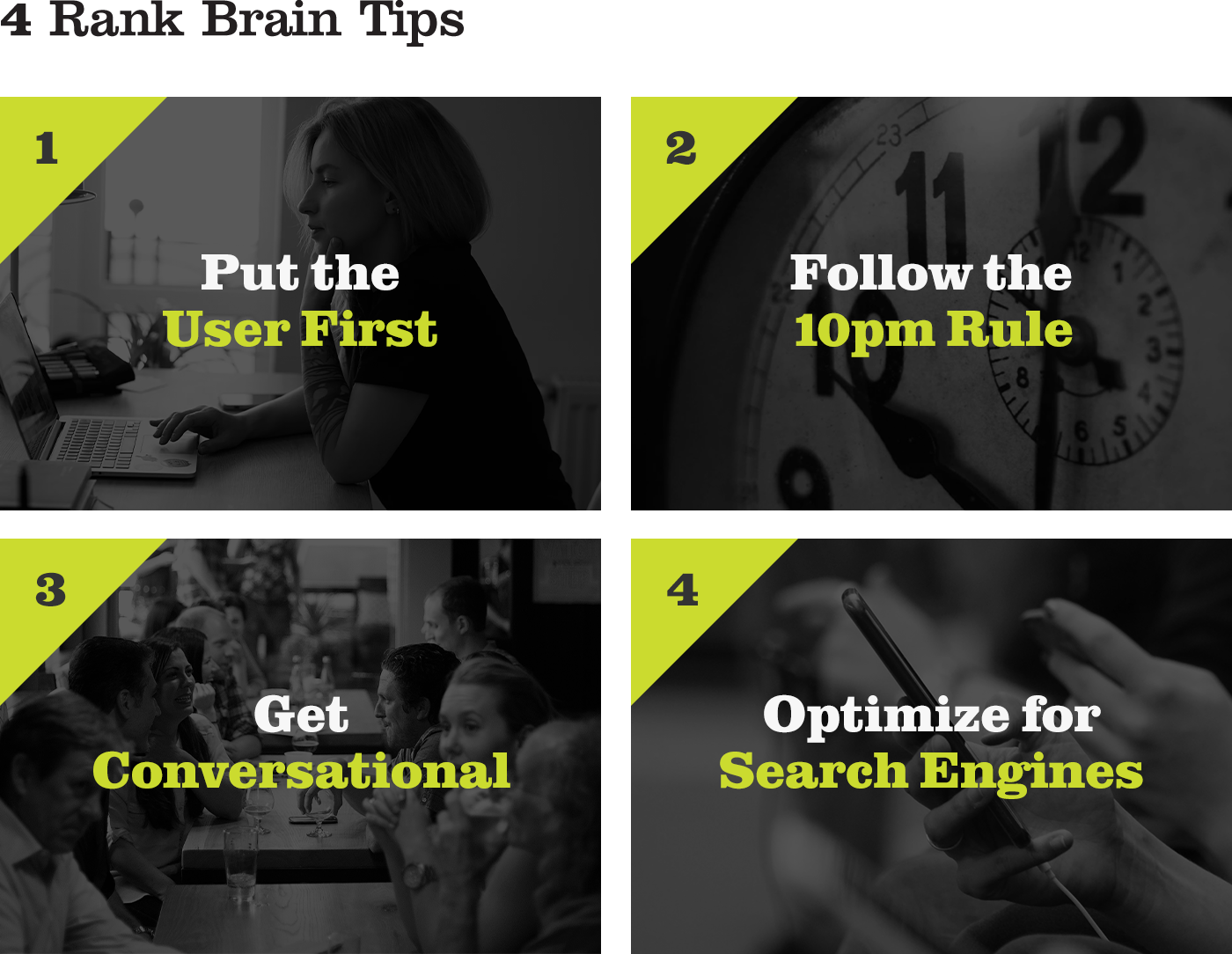
Around the dinner table during a Sunday cookout, my daughter asked a group of her 11-year-old friends, “Do you like math or reading more? That tells you if you are left-brained or right-brained.”
My first thought was, “How does an 11-year-old know the difference between left- and right-brained thinking?” :-)
As a digital marketer, my second thought was, “I want to think like Google’s Rank Brain instead.”
What is Rank Brain?
Google’s Rank Brain is essentially the language of Google. It’s Google’s ever-evolving artificial intelligence that sorts through millions of user searches and presents a list of websites that match the user’s search.
Google uses more than 200 factors in its algorithm to rank websites. The technical goal of websites is to meet as many of those factors as possible -- while matching user’s intent -- to give the site the best chance to rank at the top of search results.
That’s a tall order, so let’s narrow that down a bit. How about the top 3 ranking factors?
Google’s Top 3 Ranking Signals
Google recently prioritized the 200 into the top 3 ranking signals. Number 3 was site speed, #2 was meta information, and the number one ranking signal? Content.
If you’re right-brained, (you love reading and the creative arts) that’s music to your ears. But if you’re like most of the youth who were around my dinner table on that Sunday, you like math and science more (left-brained), and so writing web content may be the last (or dreaded) thing on your to-do list. But managing web content is a critical piece of web design and development.
<<< Master All 3 of Google’s Top-Ranked Signals. Ask Us How! >>>
You might say, “Heck, we’ve got content on our site, so we’re good.” If the company has no competition and great brand recognition, then yes, you probably are OK. But if competitors are peeking over your shoulder, then you have some work to do.
Managing web content is a never-ending task, but hopefully, one that excites you as you sit down to tell the world how your company can solve their problems.
“Just the Facts, Ma’am” (Not anymore)
When the internet was born, most websites simply took their printed materials: brochures, catalogs, reports, and copy/pasted them into a webpage. Done. “Just the Facts” was good enough.
That was then. This is now, and your content must go further.
Facts are faceless. Everyone has facts. And for large industries like health care and banking, the most dangerous thing can be to make the sites too similar. Competition for customers' eyes gets more intense by the minute. You can’t just post the mission statement and services and expect clients to come flooding in.
You’ve got to do this: Make people’s lives better. Be extraordinary.
So….What’s the Difference Between Content and Good Content?
Think about what makes your company different and special. Delight customers and develop your brand. Make people want to do business with you. Don’t be afraid to showcase the company’s personality. And write about it.
Use emotion. Personalize. Be useful; Be quick; Be enjoyable. Draw people in and make them want to return.
Blog content is a great place to let your brand personality shine. Fresh content like blogging builds your company’s brand and its authority and will bring customers back to the website to do business with you.
<<< Get Help With Website Writing From Karen at LRS Web Solutions >>>
Ready to get started? Here are some best practices:

4 Tips to Create “Rank Brain” Content.
 1. Put the User First
1. Put the User First
The number one thing for great website writing? Write for your audience.
Think people are dying to download the dry, 136-page annual report? Are they clamoring to read the details about the latest inside-baseball award the company won? Are they excited that the new hire is “honored to join the company”?
Not likely.
Don’t write copy that only the boss or CEO will want to read. Write to please your website visitors – they are your potential customers, and they have one question: “How can you help me?”
Answer that question –- quickly, easily, and delightfully -- and you will rank, get clicks, and keep customers.
Think of website content like clothing. It’s not “one-size fits all” any more. To get listed in search results, your content must fit the user like a tailored suit.
Unsure who your customer is exactly? Check Google Analytics to find out who is coming to your website and write the copy with them in mind. What terms are they using to search for a company like yours?
Don’t use “our” “we” – use “you” and speak to the customer. Think about where they are in the sales funnel.
<<< Need help understanding your customer? Ask LRS Web Solutions for Help. >>>
2. Follow the 10 pm Rule

Especially when writing web content, manage words carefully. Write short and simple sentences with minimal jargon and acronyms. Follow the 10 pm rule: would you be happy to read this at 10 pm? (Or would it put you to sleep?)
Here’s a sentence from a bank’s page about the funds available for community projects:
“Requests for assistance must quantify the benefits the contributions will provide to the recipient(s) and the community in general.”
Fun to read? Or did you doze off? Most likely this sentence was copied directly from a corporate philanthropy report for the Board of Directors, not written for an event coordinator who actually wants to know how to get a fundraising grant.
How could this sentence be improved? Find out in the next section.
3. Get Conversational

More people are searching online with a “conversational search” query. Google reports that people are searching with words like “do I need” or “should I” “can I”. Such as “How much do I need to retire”. Google calls this “For Me” searches. So, when updating website content, think about how you give advice to customers one-on-one and use conversational phrases.
This is more and more critical as mobile use skyrockets and more people are verbally asking Siri, Alexa or another AI technology a question while they make dinner, repair a household item, drive to a meeting or just have tired thumbs. Optimizing your content for voice search is going to be critical in the months and years ahead
<<< Get help optimizing your content for user’s queries and voice search >>>
So how would you improve the “Request for Assistance” sentence in the previous section?
How about, “If you’d like XYZ Bank to sponsor your community event, let us know how the event will help people and improve our community.”
Use concise, everyday language – long sentences, jargon, and acronyms won’t impress your readers, it will only frustrate them. Imagine you are talking directly to your customer when writing. What words would you use face to face?
4. Optimize for Search Engines

Search Engine Optimization (SEO) is a complex mix of art and science, a mix of technical checks and creative wordsmithing. It means researching industry-specific keywords and using them in the page headlines, title tag, meta information, and alt text. Check the content to make sure you are using headers (H2-H6) in order to structure the pages to help the algorithms understand the content. Advanced specs like schema further helps search engines understand the content of the page.
<<< SEO help is just a click away. Contact LRS Web Solutions. >>>
Whether you’re left-brained or right-brained, you now have some tips to think like Google’s Rank Brain.
Partner with Karen at LRS Web Solutions to power up your content to match Google's Rank Brain.